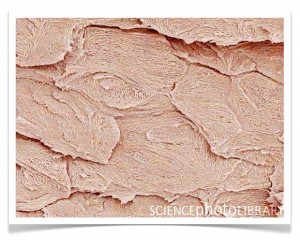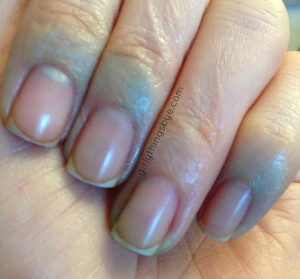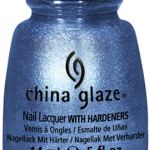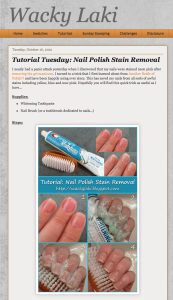Polish Stain Removal Tips
Polish Stain Removal Tips
You've just removed a gorgeous, dark blue and look down in horror—your nails are now a lovely shade of blue!
This recently happened to me with China Glaze Blue Bells Ring #1119.
Of course instead of panicking, I get all geeky! "Oooo, this will make a great article!"
Since I've read just about every nail blog post about polish stain removal, I thought I would share my insights gained by de-bluing my nails.
I'm also including the stain removing methods I don't recommend and why they're a bad idea.
My Steps For Preventing Polish Stains
1. In spite of using two coats of basecoat to protect my nails, expensive polishes can stain too.
2. It's extremely critical to do the one-cotton-ball method of polish removal, using pure acetone, with plenty of soaking time—especially if you're dissolving 5 to 10 layers.
[video below]
3. Remove polish in ONE firm, clean stroke.
4. Remove any remaining polish with a CLEAN piece of cotton and A LOT more acetone.
5. If the nail plate looks stained a lighter shade of the color, use a clean cotton piece saturated with A LOT of acetone and keep wiping/scrubbing. Focus on wiping nail tip to eponychium, since nail cells grow layered like house roof shingles, you want to go against the grain.
6. Use Q-tips saturated in acetone to get staining at the eponychium curve ("cuticle" line).
7. Wash hands with warm water and soap.
8. Scrub nails top and bottom with a nail brush. Rinse. Dry.
9. Apply your favorite penetrating nail oil generously and rub in. (Blue stains are all gone. :) )
One-Cotton-Ball Polish Removal
All Lacquered Up introduced us to Deborah Lippmann's easy polish removal method on YouTube.
She completely saturates the cotton with acetone and pulls the cotton apart as you'll see in the video. I prefer to unroll a cotton ball and cut small pieces.
Acetone saturation is very important—and it's extremely COLD! It feels like you're soaking in ice because acetone evaporates so fast.
This is why I recommend coating your skin with a cheap kitchen oil before removing your manicure.
It blocks some of that numbing cold and prevents acetone from dissolving your precious body oil and drying out your skin.
It's also tough to see in the video, but Ms. Lippmann is saturating a second cotton with acetone to wipe of the first piece of cotton. This is an important step as well you help you get a firm grip to remove the polish in one, clean swipe.
Removing Immediate Stains
If your nails are still tinted after trying all of my tips, you may need to bring out the big guns..... or big goop.
Anutka at Wacky Laki has put together a great tutorial using whitening toothpaste for immediate polish stain removal.
Fortunately, I haven't had to use this technique, but it's nice to know it's an option.
No Buffing Please!
It's surprising to me how many established nail bloggers recommend buffing the stain out—even though this is a horrible idea!
It's quite understandable why they recommend it though. Immediate polish stains usually are because polish pigment has settled into the top few layers of nail keratin.
This happens really easily with the traditional polish removal method—saturate a cotton ball and scrub the heck out of it until the polish is dissolved.
 Nail Keratin Cells Under Electron Microscope
Nail Keratin Cells Under Electron Microscope
Even though our nails appear smooth, under an electron microscope, it's possible to see that our nails are made up of hundreds of thousands flattened keratin cells.
As in the photo to the right, you can see the microscopic gaps between the cells.
Polish pigments are small enough to settle into those gaps with enough force.
The acetone is dissolving the colored lacquer, but your scrubbing action is driving the dissolved pigments into the top layers of keratin.
The traditional thinking is, "I'll just buff the stain out, since it's only in the top few layers."
But like I addressed in my previous article about why buffing out ridges is actually making our nails weaker, the same holds true when buffing out stains.
You only have about 100 layers of keratin in your nails.
It seems like buffing a few layers won't hurt, but it only makes your nails thinner, weaker, and more prone to breaking.
 Who's Guilty?
Who's Guilty?
The photo to the right by GirlyThingsBye demonstrates perfectly how scrubbing can even cause the pigment to be pushed into the top layers of our skin too!
This photo was taken after several rounds with acetone and she says it took several days for her skin to return to normal flesh color.
This is leads me to think . . . who's the real guilty party with most polish staining?
You know that saying... "When you're pointing at someone else, you have three fingers pointing back at you."
Should polish brands be condemned for causing staining? Hummmmm.
Be Careful with a Soak
There a couple of other methods recommended by bloggers which I don't recommend.
They are soaking your nails in hydrogen peroxide, lemon juice or denture remover tabs.
These techniques may work, but at what cost to the health of your nails?
One of the very worst things you can do to your nails is soak them for 5-15 minutes in a water based solution with some additives.
Even though our nails can soak up three times their weight in water, it's very damaging to the keratin layers.
Where does that water go?
In between every single nail layer, slowly pushing the layers apart.
Our nails are resilient, but not for long. I explain this process in more detail here: http://www.nailcarehq.com/How Water Damages Nails
In Conclusion
Hopefully, this clears up some confusion about polish stain removal.
The best method is prevention.
It starts with using two coats of a high quality base coat and to completely dissolve the polish before using only one stroke to remove it.
 US Dollars
US Dollars
 CAD
CAD
 Euro
Euro






